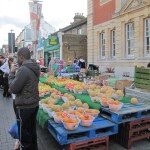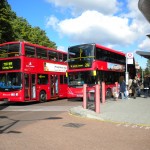September 11th, 2010 · 2 Comments
While visiting the British Museum several nights ago, I noticed an interesting behavior exhibited by different ethnic groups, depending on the culture focused on in a given room. The exhibits that I was looking at that particular evening (Ancient Greeks and Ancient Asians) were rather diverse, and it was precisely this diversity that alerted me to this phenomenon. While wandering through room after room of Greek artifacts, I noticed that Asian visitors (with only very few exceptions) would pass through these rooms without stopping to actually look at many, if any, of the artifacts. I slowed my pace considerably through the remainder of the exhibit, to observe the most number of people, and sure enough, Asian visitor after Asian visitor passed through the rooms, only occasionally stopping to look at one artifact, or more likely, take a picture, before moving on. Compared to visitors who looked to be of European/American ancestry, the difference is stark. These people generally took their time through the exhibits, stopping to gawk at an exceptional pot or other artifact, and generally going at a more suitable pace for such a wonderful museum (in my opinion).
Intrigued by this, I moved on to the Asian exhibits to see if I could find a similar trend there. Sure enough, I did, but it was almost completely reversed. In this case, the Asian visitors were the ones that were slowing down to look at everything, while the people that were zipping through were almost entirely Caucasian. This is exactly what I expected to find, as my hypothesis prior to entering the Asian room was that people, whether consciously or subconsciously, care more about cultures closest to their own, and are therefore more interested in the history of these cultures. This is why those of Euro-American heritage took their time through the Greek exhibits, but zoomed through the Asian room, while the Asians exhibited the opposite behaviour.
All this may either be evidence for or against the British Museum. This small, unscientific experiment of sorts seems to show that people don’t care about other cultures, at least not as much as their own. It’s very easy to extrapolate this to all sorts of things (for example, various imperialist wars in the Middle East, religious intolerance all over the world, etc.), but I don’t want to make this post too upsetting, so I won’t dwell on sad things, and get back to the Museum. I’d rather think that this phenomenon shows that the Museum has something for everyone. No matter where you’re from, you’ll find a piece of our history at the British Museum. I’d like to think there’s a bit of hope left in the world, so I thoroughly believe that this latter theory more true than its predecessor.
Interestingly, to finish things off, I travelled to the Americas section of the museum to see what kind of demographics it attracted, to compare to my observations in the Greek and Asian sections. I found that no one, no matter who they were or what they looked like, just buzzed through. Everyone was transfixed by the Native American headdresses and canoes, but I found no Americans in the exhibit (It’s surprising how easy we are to pick out, once you live in another culture for a while). This seemed exactly contrary to my other findings, as going off of my findings, you would expect to see a whole gaggle of Americans in the part of the museum dedicated to their history. On closer inspection however, this makes perfect sense. The vast majority of Americans are not of any measurable Native American descent. Instead, we’re predominantly from Europe and Asia, which incidentally are the exhibits in which I found all the “missing” American visitors. This “exception” seems to in fact further prove the rule, as Americans, as part of a “melting pot,” still associate closely with the history of their international forefathers.
Tags: 2010 MatthewM · Museums
Our morning started out great: a nice breakfast, an exciting market to explore, and a seemingly easy route to the Walthamstow market. Upon arriving at the Warren St station, we discovered that the Victoria line, crucial to arrive at Walthamstow market, was closed for engineering. We had been warned that we might want to check to see if all of the lines were working as usual over the weekend… However, we all took that as a “make sure you know where you are going” warning rather than a “look up the closed lines online before you leave” instruction. Oops. Once we figured out how to get to Walthamstow (Central line to Liverpool Street Station to catch the National Rail up to Walthamstow Central), it was a breeze. An hour’s worth of breeze, in fact. Once there, we quickly located the market, which was about a block away from the station.
Our destination, Walthamstow market, had a wonderful selection of fruits, vegetables, clothes, pots and pans, handbags, toys, lace, material, and other random items- all very reasonably priced. People arrived with empty bags with wheels to carry their shopping home. (One lady complained to a friend that she had bought too much and her husband was going to fuss at her.)
It was a very demographically diverse area, we saw people from various countries in Africa, Eastern Europe, the Middle East, and India. In the couple of hours we were there, we heard at least ten different languages. The vendors themselves were predominantly English or from the Middle East. When walking around the community, we noticed a multicultural center, giving us the impression that the community was aware of its diversity and more than likely sought a way to embrace it. Around the market were more specialized stores, which included fabric stores, grocery stores, candy stores, a Pound Power store (everything was a pound; equivalent to the American 99₵ store), and most importantly, a variety of cultural restaurants.
On our way back to the Arran House, we decided to be just a bit more touristy and take a double-decker bus to see more of the area and London itself. Seemingly great idea, but like this morning, it became a hugely complicated decision by a number of factors. Firstly, we weren’t sure what route to take because we were unsure of where in England they would take us. Secondly, when we did decide what route would be the easiest, we were unaware that the bus station we were at contained two other platforms; therefore we assumed the bus that would be the easiest to get back to the house did not stop where we were. After waiting for an alternate bus, only to watch it get full and drive off, we discovered our original bus did stop there- just further up the street! We ended up taking the 48 bus to Liverpool St station, catching the Central Line to Tottenham Court Rd and transferring to the Northern Line to Goodge St. Can you say HOME SWEET HOME?
For more info: http://www.walthamforest.gov.uk/index/environment/walthamstow-market.htm
[kml_flashembed movie="http://www.youtube.com/v/nvHDEVwQrjY" width="425" height="350" wmode="transparent" /]
Video on YouTube
Tags: 2010 Jamie · 2010 MatthewM · 2010 Stephenie
September 12th, 2009 · No Comments
This post is in response to the excerpt that Professor Qualls shared with us from his upcoming book. In this introductory chapter, he raises several key points which translate into our discussions about race, ethnicity and identification in London.
First, he uses the term “identification” rather than “identity.” I feel that this terminology is much more appropriate – even somehow liberating – in that it implies a choice and agency whereas the term “identity” connotes a sense of inescapability.
Second, Professor Qualls claims that “[a]s with memory, urban identifications are both internally and externally manufactured.” This can be seen in London, especially. The language barrier and cultural difference that immigrants inevitably experience coming to a foreign country certainly play a role in this “process of identification.” It is reasonable that immigrant communities would identify much more readily with a community that theirs their cultural, religious and linguistic traditions. It is the external forces, then, that cause problems.
Indeed, Qualls mentions that “[i]dentification can be either categorical or relational.” When outsiders (external forces) categorize or imagine relationships between immigrant groups where none might exist at all*, they are essentially “othering” those populations, isolating them from the rest of society and making it virtually impossible for any foreigner to feel comfortable here, let alone the possibility of “assimilation” – which I think is a completely ethnocentric idea to begin with.
It is not the responsibility of immigrant populations to adapt to the country in which they are residing, so long as they learn to respect that country. But this is a two-way-street. Locals must also learn to respect those immigrant populations which whom they share their space.
Particularly in London, these unique immigrant communities are what makes the city uniquely “London.” Or, to, yet again, quote Qualls: “maintaining past traditions was essential to the stability and happiness of the population, which in turn would reflect well on the central regime.”
*Some of you may remember the story Andrew Fitzgerald, Andrew Barron and I shared with you at the beginning of the course: At our market in Elephant and Castle, we witnessed an altercation between a darker-skinned customer and a white, cockney fruit and veg vendor. The vendor called the customer a “Paki” and obviously had no legitimate basis for determining this man’s ethnicity. Just because the customer had darker skin, the cockney vendor “related” him to a Pakistani. This is a dangerous comparison which only serves to fuel racism.
Tags: Anya


